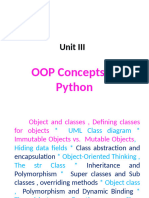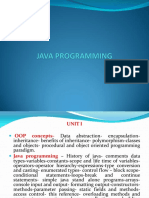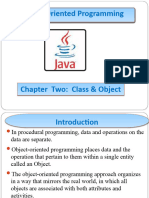0 ratings0% found this document useful (0 votes)
7 viewsObject-Oriented-Programming.pptx
Object oriented programming computer
Uploaded by
saurav PandeyCopyright
© © All Rights Reserved
Available Formats
Download as PDF, TXT or read online on Scribd
0 ratings0% found this document useful (0 votes)
7 viewsObject-Oriented-Programming.pptx
Object oriented programming computer
Uploaded by
saurav PandeyCopyright
© © All Rights Reserved
Available Formats
Download as PDF, TXT or read online on Scribd
You are on page 1/ 6
OOP : Characteristics
► Emphasis on data rather than the procedure
► Programs are divided into objects.
► Data structures are designed in a way that they characterize objects.
► Functions and data are tied together in the data structure so data abstraction is
maintained.
► Data is hidden and can’t be accessed by external functions.
► Objects can communicate with each other through functions.
► New data and functions can be easily added whenever necessary.
► Follows bottom-up approach.
OOP
OOP : Features
► Object and Class
► Encapsulation
► Data Abstraction
► Inheritance
► Polymorphism
Object and Class
An object is a bundle of variables and related functions.
It is the entity in an object oriented system through
which we perceive the real-world around us. It is also
defined as an instance of class. Objects are defined
with their properties and methods. If we take a car as an
example of object;
properties : color, company, model, fuel
methods : braking, accelerate etc.
Class is a blueprint that specifies what data and
functions are to be associated with the object. It serves
as a plan or a framework where the objects are
created.
Object and Class
The block diagram here is the representation of
Car
Class named Car. It has got properties: Name,
Model, Color and Seats and the methods : Start(),
Name Stop() and Accelerate(). So far, with these
Model
Color description, a blueprint for objects are ready but it
Seats has not been created yet. To create the objects,
we need to follow the following syntax:
<className><objectName>;
Start() For example;
Stop() car c1;
Accelerate()
Here, car is the classname and c1 is the object
name.
Class vs Objects
Class Object
Class is a data type Object is an instance of class data type
It generates objects It gives life to a class
It is the prototype or the model It is an entity where class definitions apply
It doesn’t occupy memory It occupies memory
It can’t be manipulated for its not available in It can be manipulated.
the memory
You might also like
- Chapter 03 Object Oriented Programming and Exceptions in PythonNo ratings yetChapter 03 Object Oriented Programming and Exceptions in Python70 pages
- Principles of Object-Oriented Programming in JavaNo ratings yetPrinciples of Object-Oriented Programming in Java21 pages
- Chapter 4 Object-Oriented Programming (OOP) ConceptsNo ratings yetChapter 4 Object-Oriented Programming (OOP) Concepts36 pages
- Unit 2 Object-Oriented Methodology-2: Structure Page NosNo ratings yetUnit 2 Object-Oriented Methodology-2: Structure Page Nos14 pages
- Chapter 2 System Analusis and ModellingNo ratings yetChapter 2 System Analusis and Modelling167 pages
- Object-Oriented and Event-Driven Programming: Prelude To Programming, 6Th Edition by Elizabeth DrakeNo ratings yetObject-Oriented and Event-Driven Programming: Prelude To Programming, 6Th Edition by Elizabeth Drake43 pages
- Introduction to Web Services Development (CS311) - Updated HandoutsNo ratings yetIntroduction to Web Services Development (CS311) - Updated Handouts96 pages
- What Is An Object Diagram in UML?: Similarities To The Class DiagramNo ratings yetWhat Is An Object Diagram in UML?: Similarities To The Class Diagram7 pages
- Introduction To Web Services Development (CS311) - Updated HandoutsNo ratings yetIntroduction To Web Services Development (CS311) - Updated Handouts354 pages
- Data Structures Through C++: Chapter - 1 1.1. C++ Class Overview-Basic Oop ConceptsNo ratings yetData Structures Through C++: Chapter - 1 1.1. C++ Class Overview-Basic Oop Concepts31 pages
- Chapter 03 Object Oriented Programming and Exceptions in PythonChapter 03 Object Oriented Programming and Exceptions in Python
- Chapter 4 Object-Oriented Programming (OOP) ConceptsChapter 4 Object-Oriented Programming (OOP) Concepts
- Unit 2 Object-Oriented Methodology-2: Structure Page NosUnit 2 Object-Oriented Methodology-2: Structure Page Nos
- Object-Oriented and Event-Driven Programming: Prelude To Programming, 6Th Edition by Elizabeth DrakeObject-Oriented and Event-Driven Programming: Prelude To Programming, 6Th Edition by Elizabeth Drake
- Introduction to Web Services Development (CS311) - Updated HandoutsIntroduction to Web Services Development (CS311) - Updated Handouts
- What Is An Object Diagram in UML?: Similarities To The Class DiagramWhat Is An Object Diagram in UML?: Similarities To The Class Diagram
- Introduction To Web Services Development (CS311) - Updated HandoutsIntroduction To Web Services Development (CS311) - Updated Handouts
- Data Structures Through C++: Chapter - 1 1.1. C++ Class Overview-Basic Oop ConceptsData Structures Through C++: Chapter - 1 1.1. C++ Class Overview-Basic Oop Concepts



























































